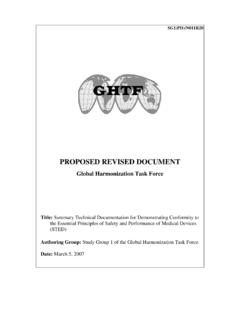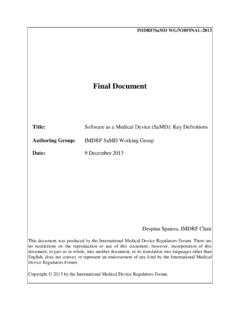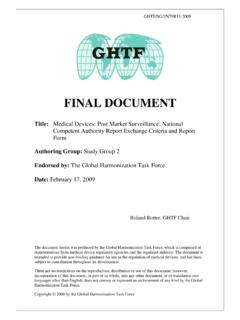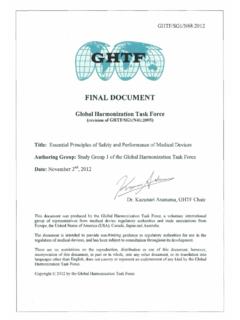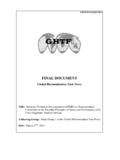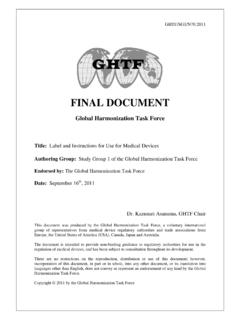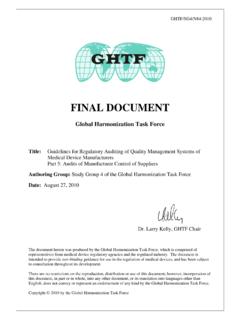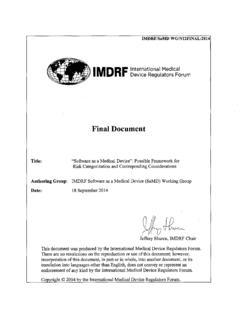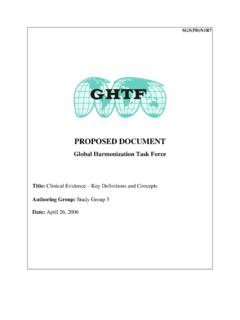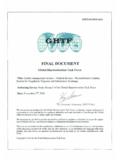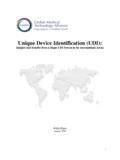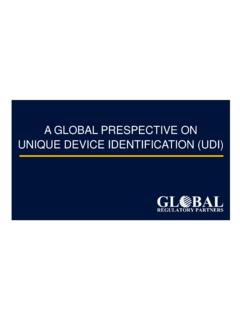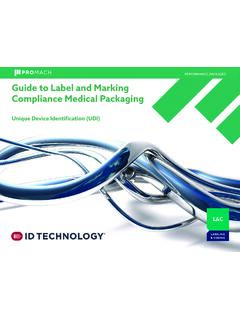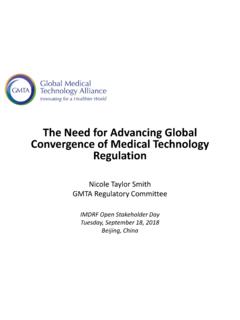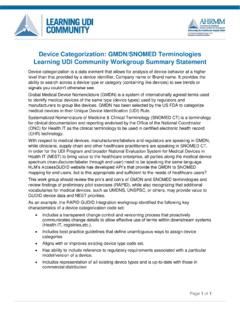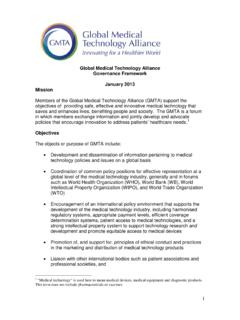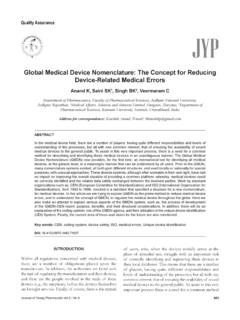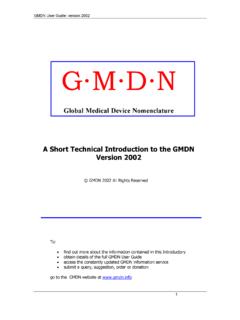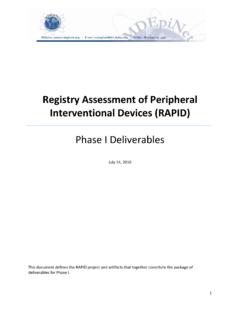Transcription of Draft New Work Item Proposal (NWIP)-revised For …
1 Date: Page 1 of 3 Draft New Work Item Proposal (NWIP)-revised For Management Committee consideration (Please submit NWIP to IMDRF secretariat via Proposed title of the project Development of common terminology and code related to adverse event of medical device Initiator IMDRF MC members Purpose and Rationale (including a reference to one or more of the goals or objectives of the IMDRF) Purpose To improve, harmonize and where necessary expand the terminology and systems being used to code information relating to medical device adverse events. The AE terminology will be composed of three parts: terms for medical device malfunction, terms for patient/user outcome and terms for part/component of medical device. (Note: Evaluation terms and code is not the scope of this WG) Rationale A comprehensive, improved terminology and coding system for adverse events will: Help regulatory agencies by enabling them to analyze safety information about medical devices with higher accuracy and reliability, and by facilitating communication about medical device adverse events between regulatory agencies using various languages.)
2 Help regulated industry by reducing the burden of managing safety information on medical device products and reducing the burden of preparing multiple adverse event reports and other safety information to regulatory agencies. Widespread use of an improved coding system will improve signal detection by adverse event management systems enabling a faster response by both manufacturers and regulatory agencies, and reduce the burden on manufacturers in reporting common, well known adverse events. Scope (including outline of issues to be addressed and opportunities for regulatory convergence) Issues to be addressed Between 2009 and 2011, ISO TC 210 worked in conjunction with GHTF SG2 and FDA to produce ISO/TS 19218 - 1 medical devices - Hierarchical coding structure for adverse events - Part 1: Event-type codes (2011, Amd 2012) and ISO/TS 19218 - 2 medical devices - Hierarchical coding structure for adverse events - Part 2: Evaluation codes (2012). These two codes are intended to be used alongside the global medical Device nomenclature (GMDN) to provide a fairly complete coded description of an adverse event.
3 Date: Page 2 of 3 {Adverse Event Code} = {GMDN} + {Event Type Code} + {Evaluation Code} for example: {Defibrillator, external, emergency} + {failed to operate} + {electrical component malfunction, short circuit} The ISO/TS 19218 code tables are based on the coding system being used by the FDA, except that the FDA uses a hierarchy that is up to six levels deep, whereas ISO/TS 19218 describes only a two level hierarchy. As a result, there are some discrepancies between the FDA coding structure and ISO/TS 19218. ISO/TS 19218 Parts 1 and 2 have been implemented in full by Australia s TGA and in Europe by the UK s MHRA. Health Canada has adopted a hybrid of the FDA s coding structure, ISO/TS 19218 and unique Canadian codes. There is now a great deal of experience in the use of ISO/TS 19218 and the predicate coding system on which it is based, and it is clear that it can be improved. Some examples are: 1. Codes are missing in both the Type and Evaluation code tables.
4 2. Some codes that appear in the Type code table belong in the Evaluation code table and vice versa. 3. Codes for patient/user outcome and part/component of medical devices are missing, 4. There are some who argue that the two level hierarchy described in ISO/TS 19218 is insufficient. At least three and maybe more levels are needed. 5. A payment is required for the ISO standards, but the guidance document will be free. It is expected that the codes described in ISO/TS 19218 needs to be used alongside other information, some of it coded, to provide more complete information about adverse events. Annex A: of ISO/TS 19218 allows for the use of additional codes, such as a patient outcome code, and a device description code, and some IMDRF members have suggested that Health Industry codes (radiology, oncology, general surgical, etc) would also be a useful addition. These codes could allow adverse events to be more precisely described, but the tables for such codes have not yet been developed.
5 Proposal The work will be divided into two steps. First Step : establishment of the harmonized hierarchy concept for AE terms Review existing AE terms. (pick several samples of terms from each member ) Find difficulties or differences Review the hierarchies concept and reach a consensus of it Second Step : Further discussion towards implementation Discuss how to utilize existing systems such as ISO/TS 19218, FDA s system and etc. For the parts and components level, we may review global medical Device nomenclature (GMDN). Find possibility for collaboration with ISO TC 210. Discuss single code concept or alternative ways such as to create a map with other codes. Discuss the maintenance issue Publish the IMDRF recommendation document Date: Page 3 of 3 Developing evaluation terms and codes can be discussed later as the Work Item Extension of this Proposal . Opportunities for regulatory convergence Summary reporting of coded events is beginning to replace full reports on adverse events.
6 Utilization of the whole or part of the common terminology and coding system by each regulatory authority can contribute to the convergence of activities associated with adverse event reporting and investigation (vigilance). The additional code tables for describing the device involved in an adverse event could contain elements of the Unique Device Identifier (UDI). General Work Plan and Timelines Revised new work item Proposal to the IMDRF Management Committee for consideration in March 2015 in Tokyo. Identification of approximately 15 workgroup members. Workgroup established by the end of April 2015. Work via email exchanges, teleconference/web meetings as well as face-to-face meetings during 18 month period as determined by the workgroup members. Approximately one face-to-face meeting per every 6 months is anticipated. Prepare Draft paper on the discussion of the First Step by the end of Jul. 2015 for consideration of the IMDRF Management Committee at Sep.
7 2015 meeting. Move onto the Second Step. Draft the summary of the WG results and prepare the Draft by the end of Feb. 2016 for consideration of the IMDRF Management Committee at 2016 meeting. Public comments to be received by May of 2016 Resolve comments and prepare Final document by Sept 2016. Seek collaboration with ISO/TC210 to revise current ISO/TS 19218 based on the deliverable of this work item after finalizing the document. Proposed project leader Current IMDRF Management Committee Member Proposed sources of necessary expertise IMDRF members and industries members Relevant existing documents at IMDRF or GHTF and national level, as well as in international bodies. ISO/TS 19218 - 1 medical devices - Hierarchical coding structure for adverse events - Part 1: Event-type codes (2011, Amd 2012). ISO/TS 19218 - 2 medical devices - Hierarchical coding structure for adverse events - Part 2: Evaluation codes (2012). FDA coding system for medical Device Adverse Events (Public Document) Public document developed with MHLW (Japan), where the compatibility with the terms used in the FDA and the ISO has been also considered.
8 IMDRF-3 NWIP Template: December 2012
